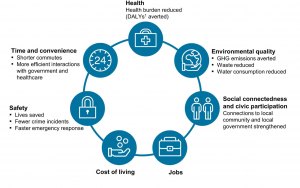By Zari Subhlok
With technology so integrated in our everyday lives, it’s only natural it would have an impact on the way cities function and how we interact with them. Quantity Surveyor and AIQS Graduate member Zari Subhlok explores ‘creating smart cities to help build the future’ in an essay which earnt her the 2021 PAQS-IWATA Foundation Travelling Scholarship.
For most people living in urban regions of the world, a usual day starts with their smart devices to help make some of the most basic decisions for the day. For example, to travel safely from point A to B, a combination of apps like Google maps, public transport apps, e-hailing services like Uber or Ola, digital payment systems, parking apps, etc are used. The same technology is also applied for more complex activities such as energy consumption tracking, telemedicine or even gunshot detection by the more advanced cities.
Technology adds value to people’s lives by providing them with the power of live data visualization at the palm of their hands. A combination of disruptive technologies such as AI, IoT, Big Data, Drone, Digital Platforms, etc allows people to make informed decisions and that has an impact on the way cities function and humans behave on a daily basis.
A framework comprising of many such technologies which aim to ‘develop, deploy and promote’ sustainable development practices to address urbanization challenges is what creates a Smart City.
Cities and Liveability
Cities are where more than half of the human population currently resides. The share of the human population that cities will host will be 68% or 6.7 billion people by 2050 as per a recent projection by the UN. It should be known that rapid urbanization does not ensure quality of life or better liveability. Liveability can be defined as the extent to which a city supports quality of life, health and wellbeing for the people who live, work or visit.
As per the UN Department of Economic and Social Affairs – providing housing, transportation, energy systems infrastructure, employment and essential services like education and health care will become incredibly challenging in the future. A city with economic growth, high liveability standards and sustainable development should be the goal of the future.
Why become a Smart City?
Population increase is expected to be contributed greatly by the developing and underdeveloped parts of the world. More than 30% (3 billion) of the world population will be living in the slums of cities by 2050. The UN says inequality intensifies divisions and hampers economic and social development. There will be a need, more than ever before, for an equitable world especially after it continues to face the devastation caused by Covid-19.
Every city contains a sophisticated network of hard, soft and critical infrastructure acting as its backbone. With the number of people increasing, the pressure to manage these systems will be high. Sustainable development of the future world will depend on how successfully cities are able to lead urban growth and thrive.
Disruptive digital technologies have the potential to solve major metropolitan challenges. Data-driven technology serves as a powerful tool to accelerate evidence-based city planning & management. By enhancing connectivity, financial inclusion, access to trade and public services, technology can be a great equaliser. A study finds that following the Smart City development agenda is not a mere alternative but a crucial strategic imperative for the developing world. Hence, the developing countries should prioritize Smart City initiatives over other development alternatives especially if they can afford a digital infrastructure.
Yokohama
A great example of remarkable development is the Yokohama city of Japan. In the 1960s the city struggled with issues such as air pollution, heavy traffic jams, excess emissions, etc. After formulating “The Yokohama Smart City Project” in 2010 and undertaking development initiatives like grid energy management systems along with the involvement of its people, private companies and the government, Yokohama became a model for the development of sustainable cities. Yokohama was able to reduce its CO2 emissions by 29%. The city now provides valuable insights for developing countries to apply smart solutions to address their urban challenge.
Power of Data (to respond to existing problems)
To move towards ‘smartness’, cities from developing countries can start with a framework that utilizes people-centric pilot programs and a low-cost technology base to deliver outcomes that enhance liveability. These initiatives can target the following sectors:
Traffic management: Smart traffic signals, car sharing, bike hire, real-time public transit information, smart parking, etc can make it possible to respond to live traffic volume, reduce congestion and promote improved transport.
Waste management: Waste collection optimization using sensor-based smart bins, waste management apps can control sanitation and solid waste pollution.
Public Health: For areas where specialized medical facilities are not available, telemedicine can be availed for remote healthcare and treatment. Telemedicine also saves hours spent on paperwork and maintains records digitally. Additionally, M-health (mobile health) interventions have been shown to improve health outcomes and reduce healthcare costs.
Aged Care: To keep the vulnerable sections of society connected, social media networks, digital citizen programs can be set up.
Crime tracking: Data can be used to counter crime, for example, predictive policing, real-time crime mapping, smart security systems, crowd management apps can all help in making a city safer for its people.
Energy and Water consumption: To control emission levels as well as reduce personal expenditure, applications like smart streets, quality and leak detection, smart irrigation, home and office monitoring systems, etc can be deployed.
Employability: To ensure citizens can find employment, e-career and online training facilities can be hosted.
It can be estimated that Smart City initiatives deliver 10-30% improvement in various sectors as shown in the image below:
Democratise the Future
Urban advancement and technological development can no longer be limited to selected countries. For the future to be bright, the world must be seen as one. The pandemic is a reminder of how interlinked everyone is, and equality is essential. Smart City initiatives are enablers for designing cities of the future in a sustainable manner. Set goals can be achieved with technology; hence a start should be made as soon as possible.
Implementation and the Quantity Surveying profession
Conception and implementation of Smart Cities will essentially be a four-step process consisting of planning, feasibility, implementation and maintenance. The four-step process will need cost experts equipped to measure, value, protect and enhance the assets of the city. Disruptive technologies like big data, artificial intelligence, and machine learning, will require the QS professional to adapt. A QS will be required to flexibly transition to the specific needs of a Smart City, for example understanding sustainable performance of cities, embodied carbon analysis, like materials and their carbon and emission impacts. Asset Intelligence for understanding digital infrastructure like sensors, platforms will be vital. A QS can provide value by managing the future maintenance requirements, optimisation of cost of maintenance and repair of a Smart City.
Historical evidence shows that the role of a QS has with ease evolved from conducting traditional services to contractual and financial expertise. Hence with the required agility and upskilling, the QS profession will be at the forefront of the Smart City innovation across the world.
Interested in finding out more? Get in touch below:




